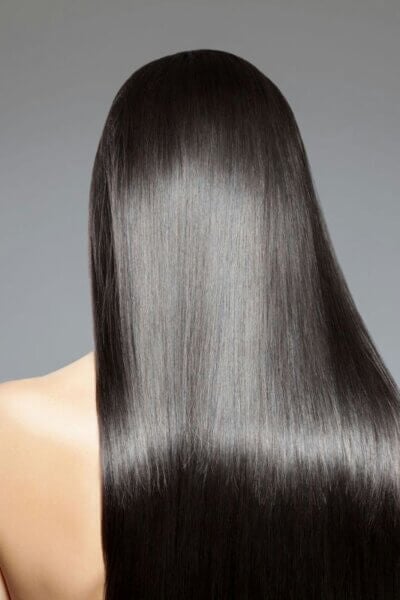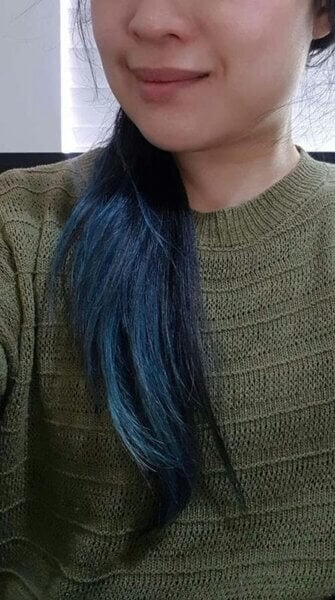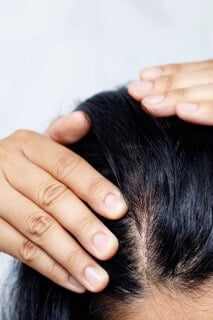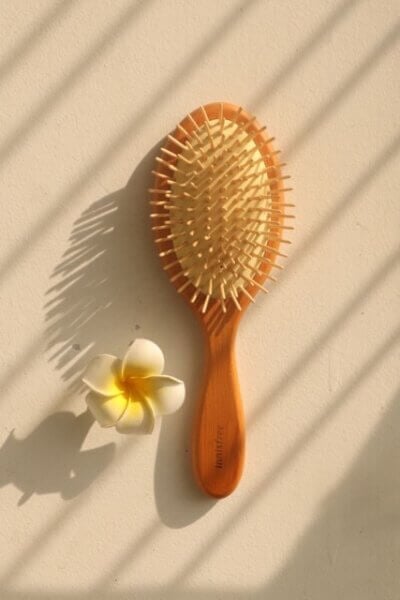Since I bleached my hair and dyed it purple (and am now slowly shifting to pink), my hair care needs have changed massively.
Related Post: My Asian Hair Bleaching Experience (Video)

Related Post: What to Expect After You Bleach Your Asian Hair
Typical straight, black East Asian, hair naturally has low porosity, with the outside cuticle lying very flat. This means that water and other ingredients don’t go in or out of the hair strand as easily, so using the wrong product didn’t have a huge effect before bleaching.
Related Post: Low Maintenance Pastel Hair Routine (video)

But the bleaching process causes the hair to end up with lots of gaps in it, so the porosity and damage increased. That meant my hair needed a lot more conditioning, and it was far pickier. Choosing the wrong product would make my hair weird and limp, or worse, rough and prone to snagging and tangles – and since bleach also made my hair weak, this would mean a ton of new split ends and damage.
So in the past 6 months I’ve gone through a long process of trial and error to work out which products and ingredients would work for my bleached hair – and it turns out, amodimethicone is my hair saviour (apart from Olaplex, of course).
What Is Amodimethicone?
Amodimethicone is a silicone. Silicones have a bad reputation in haircare, and I think it’s because of the huge range of hair types and needs. One person’s saviour is another person’s kryptonite.
Dimethicone, for example, was Michelle’s Old Hair’s hero. Dove Damage Therapy Intensive Repair Conditioner, heavy on cetearyl alcohol and dimethicone, was amazing at making my hair smooth and tangle-free.
It’s still my sister’s favourite conditioner of all time – she uses it daily, and her hair hangs down to her buttcrack like a silky shiny curtain.
Related Post: The Science of Hair Products: Shampoo and Conditioner
But after bleaching, dimethicone was no longer my friend. It made Michelle’s New Hair weird and limp.
Enter amodimethicone. It’s a silicone, but it has unique properties that have translated to soft, smooth shine for my bleached hair, although I found it a bit underwhelming for my hair pre-bleach:
![]()
Selectively attaches to damaged hair
Amodimethicone is an amine-functionalised silicone, with NH and NH2 groups. In an acidic environment, like in a hair conditioner, amine groups become protonated when H+ ions attach to them, and it acquires a positive charge.
Healthy hair is covered in a protective water-repellent (hydrophobic) layer of a fatty acid called 18-methyleicosanoic acid (18-MEA).
This layer, known as the F-layer, is chemically bound to hair, but wears off with damage, especially during oxidative chemical processes like bleaching.
When the F-layer breaks off, there are water-attracting (hydrophilic) groups left behind. Damage also leaves the hydrophilic proteins of the hair more exposed. These all acquire a negative charge in water, so damaged sections of hair are more negatively charged than the undamaged portions.
Opposite charges attract, so this means that amodimethicone will selectively stick to the damaged sections of hair more strongly.
Related Post: Busting Hair Conditioner Myths: Build-Up, Silicones, Weighing Hair Down etc.
Avoids buildup
One of the issues people complain about with silicones is that they weigh hair down – some form more durable coatings on hair that can’t be washed off easily. Over-conditioning can lead to a thicker coating on hair that can make hair feel dull and lifeless.

Amodimethicone’s amine groups decrease the chance of this happening. Since strands of amodimethicone have positive charges, they repel each other.
Any amodimethicone that’s already stuck to the hair will repel any extra strands that try to latch on. This means that the silicone film doesn’t get too thick, so overconditioning is much less likely than with uncharged conditioning ingredients.
Forms a durable film
There are two reasons for amodimethicone staying on your hair more strongly.
The first reason is the positive charge, which gives an extra stickiness to the silicone layer.
The other reason is cooler (in my nerdy opinion, anyway!). After the amodimethicone sticks to your hair, it also crosslinks. This is when the OH groups on adjacent amodimethicone strands react to form a more durable film.
This film can last through multiple washes. According to one study, some of the benefits lasted for 20 washes!
On my hair though, the silky soft feel is gone enough to require topping up every 2-3 days, even without washing – I’m guessing there’s lots of variation between products, hair types and hair routines.

Benefits of Amodimethicone
These are the benefits of amodimethicone according to cosmetic scientists:
- increased softness, smoothness and shininess
- reduced fly-away
- faster drying time
- colour protection
- thermal protection from heat styling
- improved combing
- no reduced body or volume
- increased hair strength
I’ve noticed some of these effects in my hair after using conditioners and masks that have amodimethicone high in the ingredients list.
- My hair is very noticeably smoother and softer. Instead of feeling grippy and tangle-prone, or dry and spiky, it’s soft and smooth – like a lighter version of my old hair. Sometimes I’m even tricked into thinking it’s “healthy” (although that illusion disappears once I go too many days without using an amodimethicone product)
- There’s no dullness or limpness when I just use a rinse-off amodimethicone mask or conditioner, unless I also use other conditioning products on top, like dimethicone-rich “shine serums” (sometimes still necessary when my hair is feeling too fluffy).
- I can comb my wet hair easily in or out of the shower with my fingers or a wide-toothed comb.
- My hair feels stronger and less prone to breakage, especially during brushing and combing – after using some other products, I can sometimes hear strands breaking!
- I haven’t been monitoring drying time, colour or thermal protection.
- My flyaways haven’t decreased, but I think this is because they tend to come from my hair being coarse and stiff rather than from static repulsion.
Related Post: Getting Hair Dye Off Your Hands
Rinse-off Products
My preferred way of using amodimethicone is with rinse-off products, for a few reasons:
- Washing my hair properly with water resets it into shape – sometimes the “straw” feeling is just when all the hairs dry in a bent configuration instead of smooth and aligned
- It’s hard to apply too much conditioning ingredients, since you rinse off the excess that didn’t stick
- Water makes it easier to distribute the product
Unfortunately for rinse-off conditioners, performance depends a lot on formula, so seeing “amodimethicone” in the ingredients isn’t a guarantee (although it’s given me a much better success rate!).
Toni and Guy Volume Addiction Conditioner – There are a couple of different versions of this. The one that works well for me has amodimethicone as the 3rd ingredient. I didn’t expect this to work so well, given it’s meant to be for “volume”, but I took a gamble based on the amodimethicone and it paid off. It’s on sale a lot at my usual supermarket.
Elizavecca CER-100 Collagen Ceramide Coating Treatment is meant to be a protein treatment, but I feel like the amodimethicone is doing a lot of the heavy lifting here. It’s really effective on my hair, but the tube is quite small.
Make Hair Soft Treatment – This was the product that got me hooked on amodimethicone. It was nice in my unbleached hair, but when I tried it in my hair after bleaching, there was a complete transformation. I thought I was doomed to years of babying my hair, but after using this once it was almost like I had my old resilient hair back. I’m yet to try anything else from their range, but since this wasn’t designed for damaged hair, I’m optimistic that they have even more effective products for my hair.
Essano Acai Berry Colour Protect Conditioner – I leave it in for around 3 minutes before washing it off. I’m incredibly impressed by how well this works, although I haven’t noticed a difference in hair colour fade time.
Kerastase Discipline Fondant Fluidealiste Conditioner – This has a similar effect to the Essano conditioner in my hair.
Since there’s such a wide variety of hair textures, I don’t think everyone will have the same experience with amodimethicone. But if your hair is snag-prone from damage, amodimethicone products might be worth a try even if other silicones haven’t worked for you in the past!
![]()
References
Disapio A & Fridd P, Silicones: use of substantive properties on skin and hair, Int J Cosmet Sci 1988, 10, 75-89. DOI: 10.1111/j.1467-2494.1988.tb00004.x
Yahagi K, Silicones as conditioning agents in shampoos, J Soc Cosmet Chem 1992, 43, 275-284.
This post is not sponsored, but the products mentioned were provided as PR samples for editorial consideration; however, these are still my honest opinions of the products. This post also contains affiliate links – if you decide to click through and purchase any product, you’ll be supporting Lab Muffin financially (at no extra cost to you), thank you! For more information, see Disclosure Policy.






Definitely going to try find this ingredient the next time I buy conditioner! Thanks for the informative and interesting (as always) article.
That sounds like I need it in my routine. My hair is bleached and damaged, and while Olaplex really helps, it still isn’t as shiny as it used to be.
Anne – Linda, Libra, Loca
Michelle thanks so much for this post.The timing is freaky as l had just been considering ordering some of the new Aquis haircare range that Mecca is stocking but wanted to know more about this particular ingredient as it’s so prominent(second after water) in their Primer and Leave-in conditioner.l think you should check out the range as it’s whole aim is minimising the damage which occurs when hair is wet and so protecting it before it even encounters H2O,and also after.l’m certainly intrigued,and after reading your post l think l will spring for the starter set.
Ooh thanks for the rec! I spent an hour in a hair salon the other day looking for amodimethicone-heavy products and came up with only two 🙁
New reader here… your blog is awesome. Thank you!
I recently started using Unite 7Seconds Detangler, and the 4th ingredient is amodimethicone.
I’ve been on a journey to restore and resurrect my dry and overly processed hair. While I love the scent, and it does seem to help my hair a little, I can’t say that it has been miraculous. Or that anything I’ve tried has been a “miracle”, even Olaplex. I think it’s just a matter of time, and consistently using better products that are suited to my hair.
Thanks for such an interesting article, and great timing! I was looking for a small bottle of conditioner while on holidays last month and ended up buying the SunSilk Vibrant Colour Conditioner. My hair felt amazing after using it and now that I look at the list of ingredients there’s amodimethicone there!
so interesting!
Im trying to do the curly girl method and silicones are a huge No- no
but I do colour my gray roots often and bleach for highlights a couple of times a year…trying to take care of my hair!
I was inspired by your post to look for leave-in products with amodimethicone for my color-treated hair. I came across several from Redken, John Frieda, Matrix and Paul Mitchell, and tried a John Frieda leave-in spray.
It definitely made my hair smoother, and it didn’t weigh down my roots (I HATE when my hair goes flat on top). I still need something heavier on my ends though. I also noticed my hair does dry faster which I really appreciated since I let it air-dry 99% of the time.
Yay! I’m glad they worked for you 😀
Thank you so much for this lifehack! I have weird, coarse hair with a split personality and have endured all sorts of shenanigans from it. When silicone was a new thing on the market (at least in my country), a hair dresser warned me and said it builds up on your scalp and hair, making hair stiff and plugs the follicles so new hair can’t grow thus thinning the hair. She said she could tell who was using it and who wasn’t. This was 14 years ago and I have avoided it like the plague. I have had an on-off relationship with regular conditioner since they seem to do nothing for me except making me and my bathroom smell nice.
I’ve heard really variable things about silicones from hairdressers! I think it’s probably a lot of myth with some truth behind it, but I haven’t really investigated yet…
Ok, could that be the worst brand name for a hair product?! LOL. The link for Make Hair Softer Treatment doesn’t work, and searching for it just brings up a bunch of BS ‘make hair softer’ sites LOL.
I completely agree! It’s so hard to find them anywhere online, trying to find more info on their products was a ridiculous journey.
John Frieda, Paul Mitchell, and Matrix make leave-in products with amodimethicone. I tried the JF spray, and my air-dried hair does seem to dry faster.
I’ve been looking for amodimethicone sprays – so far sprays have been mostly disappointing, I just don’t think they’re enough for my hair at the moment.
Redken Extreme Anti-Snap treatment comes in a pump bottle and has a runny gel texture, so maybe that might work for you?
For Scandinavian readers at least, I can inform that the drugstore conditioner Elvital Anti-Breakage Repairing Conditioner from L’Oreal Paris (yellow bottle) has amodimethicone as the 4th ingredient! ? The red bottle for colour protection also had the ingredient quite high up ☺️
The regenerative repair shampoo and conditioner (red and white bottles) from Dove contain amodimethicone!
Not sure where in the world they are available, at least in Scandinavia!
They don’t contain cetearyl or certyl alchahol though..
But this made me cheer quietly while reading the back of the shampoo bottles (as I always do) while showering.
I was unpacking after a move, and came across an ancient (1990s) bottle of Aussie Hair Insurance*. I remember I bought this for use when I visited relatives in the California semi-desert … it made my very long, fine, almost straight hair look great. I tried using it again … yes, it’s still an excellent product!
Looking at the ingredient list … amodimethicone is the second ingredient! Followed by a string of vitamins which they claim do the work, but we know better.
I don’t know if this product is still around but if it is and you can get it, it’s worth trying.
* I have no idea whether this is an Australian brand, or the name is marketing hype.
Hi Michelle,
What are your experiences with the similar amino silicone Bis-Aminopropyl Dimethicone?
Loreal Elvive Smooth Intense has Amodimethicone. It replaced the even better Loreal Nutri Gloss shampoo. Wish Loreal would bring back Nutri Gloss it was the very best.
Thanks for this post! FYI – chemist Tonya McKay Becker often posts very useful (and technical) articles on the chemistry of hair & haircare products in NaturallyCurly.com. Below is a link to her articles there:
https://www.naturallycurly.com/curlreading/authors/Tonya%20McKay
Love your work Michelle!
Thank you! I really enjoy Naturally Curly’s articles 🙂
Hey Michelle, is keeping the moisture within hair desirable (one of the benefits of amodimethicone)? I’ve seen in in your other posts that water makes hair vulnerable, or am I understanding incorrectly?
And having read also your other coconut oil post, I’m curious whether you’d prefer coconut oil (as it absorbs into the hair well) or silicone (I’m guess coats hair well)?
Thanks
It’s a bit tricky – you want there to be some moisture within the hair, but too much or too little is bad. Generally if your hair is undamaged and you leave it to dry in a not-too-dry-or-humid environment then it’ll equilibrate to the right amount, but if your hair is too porous (e.g. if it’s been bleached to death) then it can lose water too easily, so the amodimethicone helps with that.
I personally find that amodimethicone is much more effective than coconut oil on my bleached hair!
Hi there, if you’re still interested in a leave-in conditioner/treatment, you might want to try PRO 23 Infusium – Original. The 1st ingredient is water, the 2nd is Amodimethicone. I’m blond and can easily get ‘weighed down’ by some of the products for hair repair, but this one works great out of the shower for detangling & frizz. I’ve been using it for years,
and the only issue is that it’s not carried in stores anymore, but you can order it on-line. I just purchased a 33.8 FL oz for under 15 bucks!
I have gone to buy the Paul Mitchell product after reading this post and watching the Youtube video. Then read every single product label in the supermarket and googled. No luck apart from the 2 you’ve mentioned. Guess what I found today? A product with amodimethicone as the second ingredient, for $3!! At The Reject Shop (their own brand?). Who knew?! It’s called Argan Oil heat defence leave in spray. The rest of the ingredients also looks ok and despite having alcohol denat., it’s reasonably low on the list. I’ve taken photos but this won’t allow me to upload it. Just wanted to share with you and your followers! 😀
Oh have you looked into Drybar’s Prep Rally Prime & Prep Detangler (available at Sephora)? It’s a leave-in 🙂
I’m southeast asian with medium-thick wavy (2a-2b) hair. I am learning a lot about the Curly Girl(/Guy) Method and one of the rules I break is that I use silicones. But specifically, amodimethicone and a very similar cousin, the bis-aminopropyl dimethicone. I like bis-aminopropyl dimethicone too because it also does not build up for the same reasons amodimethicone also does not build up.
Not to keep dragging on, but I like the Pantene Hair Fall Control Conditioner because its first few ingredients go as following:
Water, Glycerin, Stearyl Alcohol, Befientrimonium Methosulfate, Bis-aminopropyl Dimethicone, Cetyl Alcohol,
There is a lot of hydrating (not moisturizing!) ingredients before it reaches the dimethicone (including the hydrating alcohols which I didn’t realize was a thing until recently!). Not to mention the cetyl alcohol right after the B-aD! I even use it minimally as a leave-in conditioner. It doesn’t hurt that its super cheap too!
I did notice you also have waves in your videos (which look extremely neat and clump together nicely. I’m so jealous). So I hope this helps you as an fellow wavy asian!
Amodimethicone can make fine, straight hair frizzy in humid climates. And I live in a humid climate so I try to avoid products that include it. Sadly, that’s nearly impossible since so many people think amodimethicone is a miracle ingredient. Any suggestions for us poor creatures who live where it’s humid?
You are my savior. I was looking for conditioner with full of ame-silicone. The last one suggested exist in the country where I’m at. Thank you so so much.
Hi Michelle,
I love your blog and vids! I read this article a few months ago and tried the essano conditioner and unfortunately it irritated my scalp. Is there any chance you ( or anyone) would have an ingredient list for the Make Hair soft mask? So I can check for possible allergens:)
That Make product isn’t available anymore unfortunately! There’s a Toni and Guy conditioner I’ve been using that’s been great and it’s often on sale – it’s the Volumising one (for some reason they decided to put it in that and not the damaged hair one…)
Thank you so much for this article, exactly the information I was looking for. I thought I was onto something after using Arvazallia ($12.95 amazon) deep conditioner that was magic on my destroyed, colored, post partum hair. Amodimethicone ingredient number 2. Thanks for providing the science!
Hi Michelle! Thanks for your article. I found the best conditioner for my hair with amodimethicone afterwards, the one from the Kundal Honey and Macademia Treatment. And you know what, they have a leave in serum with amodimethicone too. It’s from the Kundal Macademia Ultra serum. I have coarse high porosity textured 1C/2C hair.
For your readers in the US and Canada, Odele Ultra Sensitive Conditioner is an amodimethicone formula that is also fragrance free. It’s available in-store at Target.
Hi! How about amodimethicone in shampoo ? (and dimethicone as well for that matter). Is it enough to have it conditioners ? does it do anything at all in shampoos ?
It does, but generally not as much as in conditioner!
Hi Michelle! Somehow my natural white hair has become stained…either through the use of vitamin C products or products with sugar that have caramelized with the heat from styling. Is there any way to reverse or remove the stains?!
Thanks so much for the wonderful information you provide!